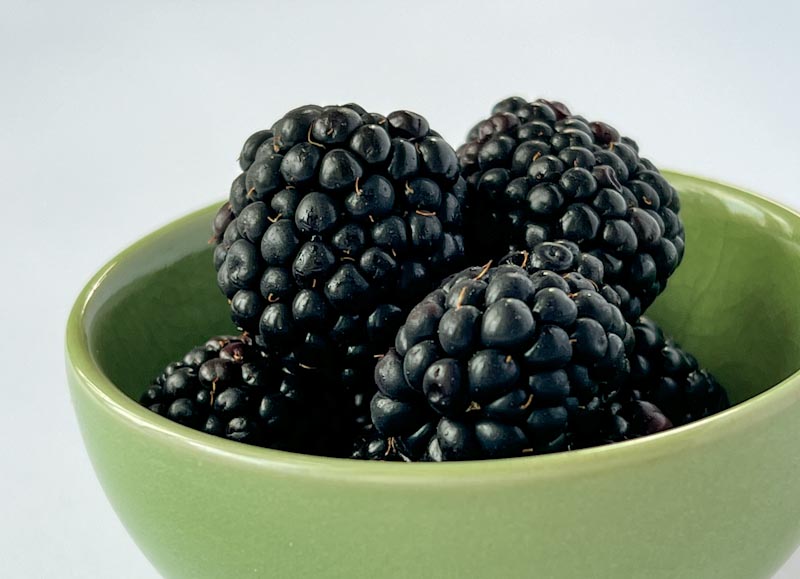
We may receive commissions from purchases made through links in this post, at no additional cost to you.
I remember picking blackberries at my grandparent’s farm in Ohio when I was growing up. They had a long fence line covered in blackberry brambles, and it was so fun to me – a suburban kid – to run out there and pick my fill. And, unfortunately, I also remember how thorny those bushes were!
It felt like a rite of passage to have to brave the spiky thorns of a blackberry bush to reach the sweet berries – although thankfully, that’s no longer the only option. Nowadays, there are many widely-available thornless blackberry varieties that you can grow at home.
It’s traditionally held that the thorny cultivars grow superior-tasting blackberries. But in recent decades, many thornless blackberry varieties have come onto the market that are just as sweet as their spiky forebears.
The following list includes the best-tasting thornless blackberry varieties, from my own experience as well as other growers’. But before we dive into the recommended cultivars, let’s first look at basic blackberry care. There are some things you can do to ensure that any variety you grow will taste the best it possibly can.
Planting and Caring For Thornless Blackberries
Choose a location that’s in full sun for your blackberry plants – at least 6 to 8 hours of direct light. Plenty of sun will help the berries ripen to their maximum sweetness. If you live in an area where the summer temperatures get very hot, pick a spot with some late afternoon shade.
Blackberries like soil that is somewhat acidic, with a pH of 5.5-6.5. The soil should be well-drained and fertile. Blackberry plants are fairly tolerant of different soil types, but they do not like to be in heavy clay. Lean, sandy soils may need to be amended with compost to help retain some moisture.
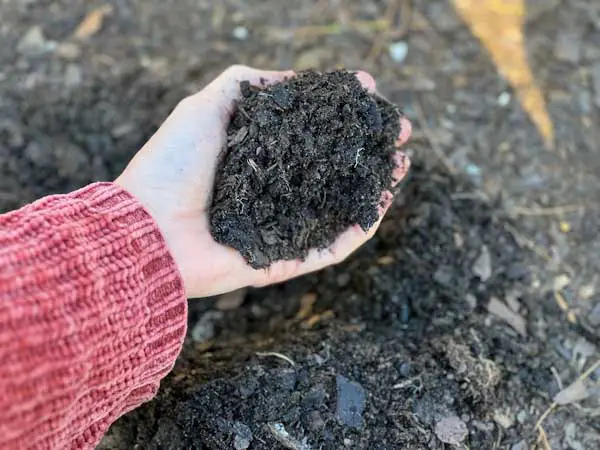
Blackberry bushes are easy to care for, but some minimal maintenance will keep the plants happier – and the berries bigger and sweeter. Pruning is a simple but essential part of blackberry care. After harvesting the berries in summer, prune the canes that grew fruit (called floricanes) all the way down to the ground.
At the end of winter, trim the remaining canes (primocanes – these will fruit the following season) to the desired height, usually 3 to 4 feet. Tip-pruning these long canes will encourage branching, which will lead to more, larger, and sweeter berries.
Find out how to prune blackberry plants in more detail in my post, The Best Times to Prune Blackberries (for a HUGE Harvest).
Blackberry plants need fertilizing in the early spring, especially if you have leaner soil (like my very sandy soil). Use a balanced N-P-K or nitrogen-forward fertilizer such as this one just as you start to notice new growth. In the fall after fruiting, spread some good organic compost or well-rotted manure around the base of the plant.
Learn more in Blackberry Fertilizing: What to Use to Grow the Best Berries.
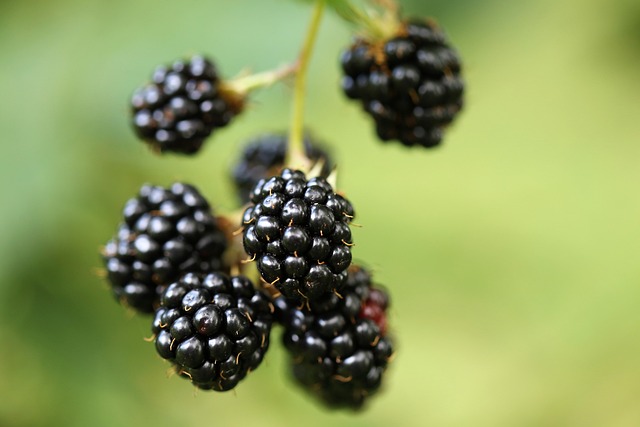
The Best Thornless Blackberries to Grow at Home
In compiling this list of the best thorn-free blackberries, I first considered flavor – which, in my opinion, is the best part about growing your own fruit. What’s the point of homegrown berries if they don’t taste at least as good as the ones at the grocery store?
Related: Why are my Blackberries Sour? Tips to Grow Sweeter Berries
I also considered other helpful factors, such as berry size, productivity, growing habit, disease resistance, hardiness, and heat tolerance. I prioritized cultivars that are generally widely available over those that are rare, extremely new, or hard to come by. Choose the best varieties for your own growing situation and climate, as well as your taste and preferences.
1. ‘Navaho’
This blackberry has perhaps the best overall flavor of all of the thornless varieties. ‘Navaho’ produces heavy yields of medium-sized, very sweet berries. This is an erect blackberry, meaning it does not need to be trellised or supported as it grows. It may, however, need to be tip-pruned a couple of times during the growing season to keep the canes from getting too long and bending over (I speak from experience).
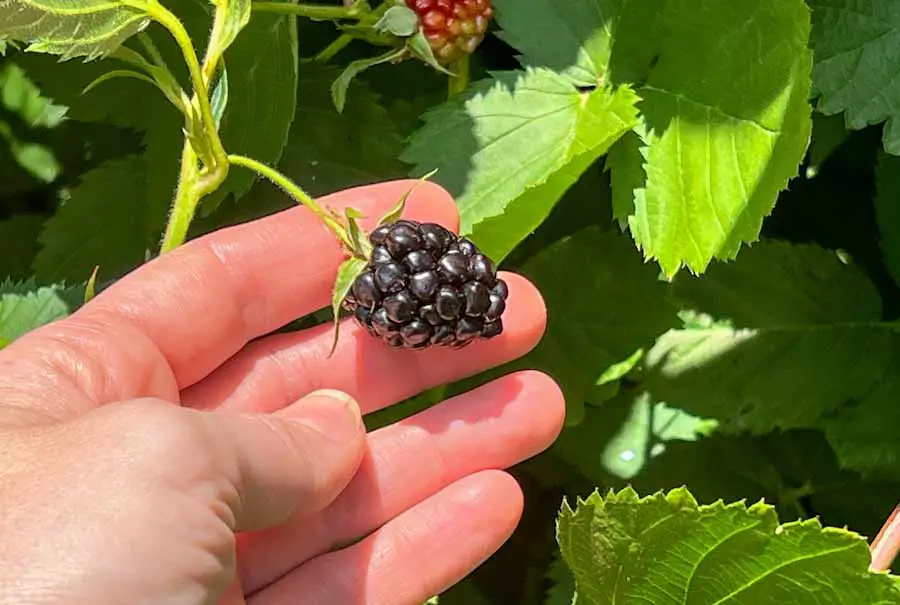
‘Navaho’ blackberries ripen in midsummer. In my zone 8b, they ripen in late June to early July, and continue producing for about a month. In cooler, more northern climates, expect berries in late July and early August.
This cultivar is more tolerant of clay soils than many other varieties. It is also resistant to some diseases, such as double blossom (or Rosette disease), although it can be prone to orange rust.
2. Arapaho
‘Arapaho’ is a cultivar introduced by the University of Arkansas breeding program (along with ‘Navaho’ and ‘Apache’, among others). Although ‘Navaho’ may have somewhat superior flavor, ‘Arapaho’ is an improvement in a couple of ways. It produces new canes more readily, shows even more disease resistance, and is ready for harvest earlier.
This cultivar produces large, 1- to 2-inch berries with good flavor and very small seeds. It ripens early in the season, around early June, and harvest lasts about 4 weeks. ‘Arapaho’ can be paired with ‘Navaho’ for an extended blackberry harvest through most of the summer.
‘Arapaho’ blackberries are resistant to cold injury, withstanding temperatures as low as -11°F. It is resistant to diseases such as orange rust and double blossom. ‘Arapaho’ is an erect cultivar, and does not need to be supported on a trellis.
3. ‘Apache’
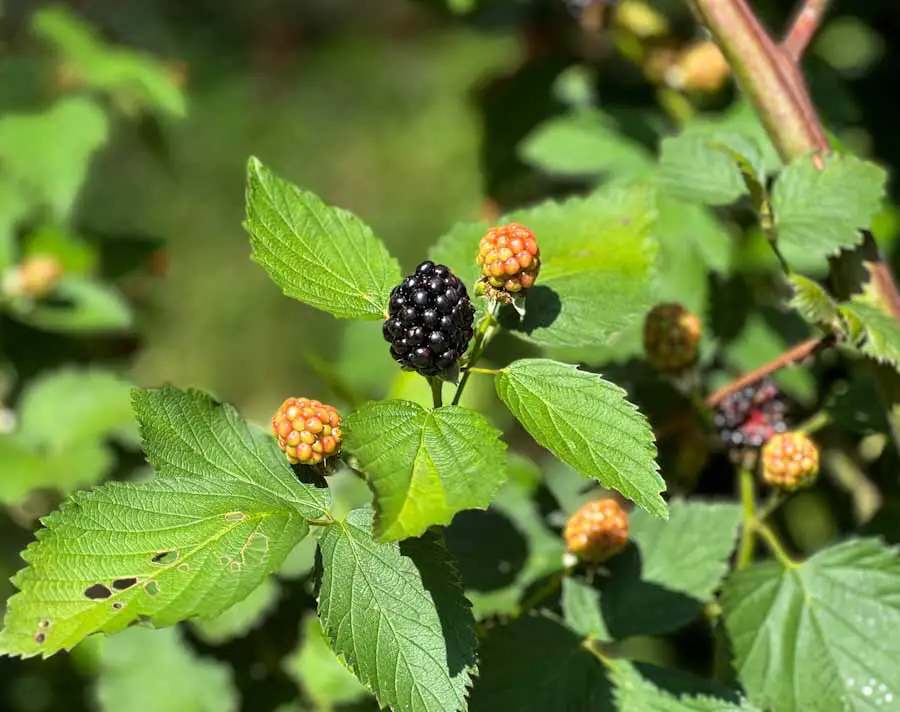
‘Apache’ blackberry plants produce large harvests of giant berries (larger than ‘Arapaho’ or ‘Navaho’). The berries are quite sweet, but a little more tart than ‘Navaho’. They ripen fairly early, in mid-June here in zone 8b.
This is an erect cultivar, so once it is established it won’t need any extra support. The canes can grow fairly long, though, so you may want to trim them as they grow to encourage lateral branching – and more fruit. The first season I planted these was very wet, and the primocanes grew to be about 10 feet long!
‘Apache’ is very cold hardy for a thornless variety, tolerating down to zone 5 with some winter protection. (See The Best Blackberry Varieties for Cold Climates for info on how to do this.) It is resistant to rust and other diseases, although it may fall victim to sunscald.
I have both ‘Apache’ and ‘Navaho’ growing in my garden. The early harvest, large berry size, and versatility of ‘Apache’ pairs perfectly with ‘Navaho’s smaller, sweeter fruit and later harvest. I have ripe blackberries available from June through July, perfect for fresh eating, baking, freezing, or canning.
4. ‘Natchez’
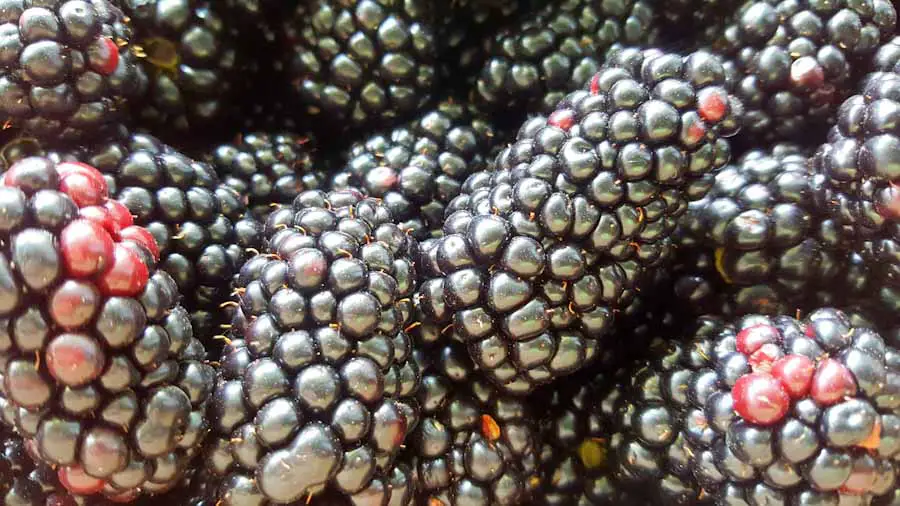
‘Natchez’ is another University of Arkansas release from 2007. It is one of the earliest-ripening thornless blackberry varieties and is ready to pick in early June (even late May in some southern zones). It ripens about the same time as ‘Arapaho’, although ‘Natchez’ is even more productive.
‘Natchez’ is a semi-erect plant, so it will perform best when supported by a trellis or fence. It will produce large, juicy, very sweet berries that are versatile and store well once picked.
5. ‘Triple Crown’
This cultivar truly is a triple threat – vigor, flavor, and productivity. ‘Triple Crown’ is one of the most common commercial varieties, and one of the best all-around blackberries to grow at home.
The fruit is large, sweet, firm, and has a good flavor and small seeds. Berries grow on semi-erect canes and ripen midseason – from late July through August. ‘Triple Crown’ doesn’t need to be trellised, though it may be helpful to provide some support so the canes aren’t weighed down by the fruit.
‘Triple Crown’ blackberries are disease resistant, cold hardy, and tolerant of heat and humidity. It grows vigorously, so provide plenty of space between plants (at least 6 feet). Expect very large harvests of big, juicy blackberries.
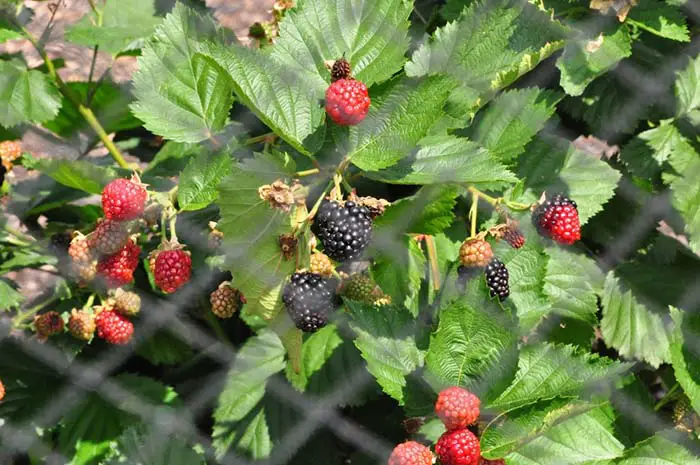
6. ‘Ouachita’
‘Ouachita’ (pronounced WA-shih-tah) is yet another great cultivar from the UA blackberry breeding program. It’s an award-winning variety that produces large, delicious, prolific blackberries.
This cultivar is notable for its disease resistance, high yields, and long harvest season. It has a longer shelf-life than most blackberries once harvested. It’s resistant to double blossom and orange rust, although anthracnose can be an issue in very wet conditions.
‘Ouachita’ is ready to be picked in early to mid-season (early June to mid-July, depending on climate). The fruit is everything you want in a blackberry – large, sweet, firm, and juicy. To get full sweetness, be sure to wait until the berries are very dark and come off of the plant without resistance.
7. ‘Hall’s Beauty’
This cultivar is a little different than the others on this list. First, it’s a trailing thornless variety (most trailing blackberries are thorny), so it absolutely must be grown on a trellis – unless you have tons of space to let it sprawl.
It’s also different because of its blossoms. All blackberry flowers are attractive, but ‘Hall’s Beauty’ has extremely large, pink and white double flowers with many more petals than the typical blackberry blossom.
‘Hall’s Beauty’ is showy and ornamental while blooming, but it also produces outstanding yields of large, firm, sweet berries. The fruit ripens early in the summer, which means less exposure to the dreaded spotted winged drosophila and other pests.
8. ‘Chester’
‘Chester’ is known for its winter hardiness and can tolerate as low as -20°F, or possibly even lower. It is the most cold hardy of all the thornless varieties, but it can also tolerate hot, dry weather. Even in high heat, the berries won’t soften or lose their flavor.
‘Chester’ is resistant to cane blight and sunburn. It produces berries that are large, firm, and mildly sweet when fully ripe. The fruit ripens late in the season, mid-July to August. ‘Chester’ is great choice for its hardiness, vigor, and productivity.
Related: The Best Blackberry Varieties for Cold Climates
9. ‘Osage’
‘Osage’ is another University of Arkansas variety, and it exhibits many of the same improvements as the others. It is highly disease resistant, adaptable to a variety of soils, easy to grow, and drought tolerant. Even with all of these qualities, the flavor of the berries is exceptional.
This cultivar is well suited to the heat and humidity of southern climates (zone 6-9). ‘Osage’ produces medium-sized, very sweet berries that ripen midseason, around the same time as ‘Ouachita’.
A Few Other Thornless Blackberries to Try
The following blackberries may not have made the flavor-first “top 9” list above, but they are all worth considering. Some of them are newer cultivars that will probably become home growers’ favorites in time, but may not yet be widely available. I’ve also included some fall-bearing thornless options. All of these blackberries have great, sometimes unique qualities that may be worth a place in your garden.
Related: Blackberry Variety Breakdown: Biggest, Sweetest, and More
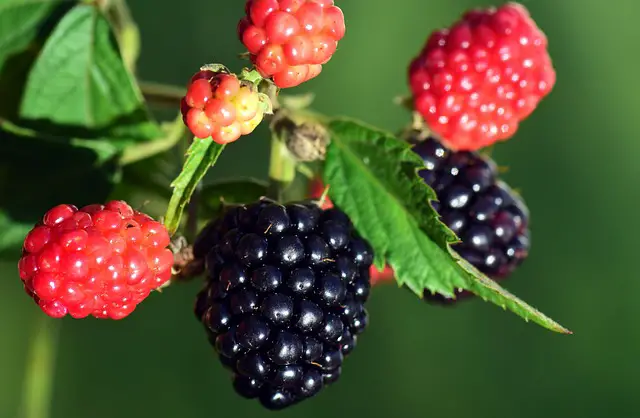
- ‘Baby Cakes’ – This is a dwarf thornless blackberry that stays only 3 to 4 feet tall and wide. It’s perfect for growing in containers or small spaces and has a rounded, bushy shape. The plant may be small, but the berries are large and sweet, often cropping twice in one season.
- ‘Von‘ – This is a newer thornless cultivar from North Carolina State University. It’s an erect blackberry with very high yields and moderate cold hardiness (zone 6-9). The berries are medium-large, sweet, with small seeds. ‘Von’ has a long harvest season peaking in mid-July and tolerates wet conditions.
- ‘Black Satin’ – This is a semi-erect plant that needs support because of its very large, sweet-tart berries. It is a disease resistant and cold-hardy variety which can be grown in zones 5-9.
- ‘Columbia Giant’ – This cultivar produces huge, long berries that can be 2 to 3 inches in length. It’s a trailing variety with high yields of juicy, mildly sweet berries. Zone 5-8.
- ‘Hull’ – This is a semi-erect variety that is often compared to ‘Chester’ – ‘Hull’ is sweeter, but not as winter hardy. It produces a moderate yield of medium-large berries. ‘Hull’ can be prone to sunscald, and is suitable for zones 5-9.
- ‘Black Diamond’ – This cultivar produces medium-large, firm berries with small seeds and a mild flavor. It has a fairly high yield, and ripens later in the season (July to August).
- ‘Prime Ark Freedom’ and ‘Prime Ark Traveler’ – These are two sister plants introduced by the University of Arkansas breeding program. They are both primocane-fruiting (also called fall-bearing or everbearing), thornless, erect plants that fruit early in the season on older canes, then again in fall on first-year canes. The berries have good flavor and large fruit, and the plants are disease resistant and heat tolerant. The main difference between the two is that ‘Traveler’ can hold up better to storing and shipping after harvest.

